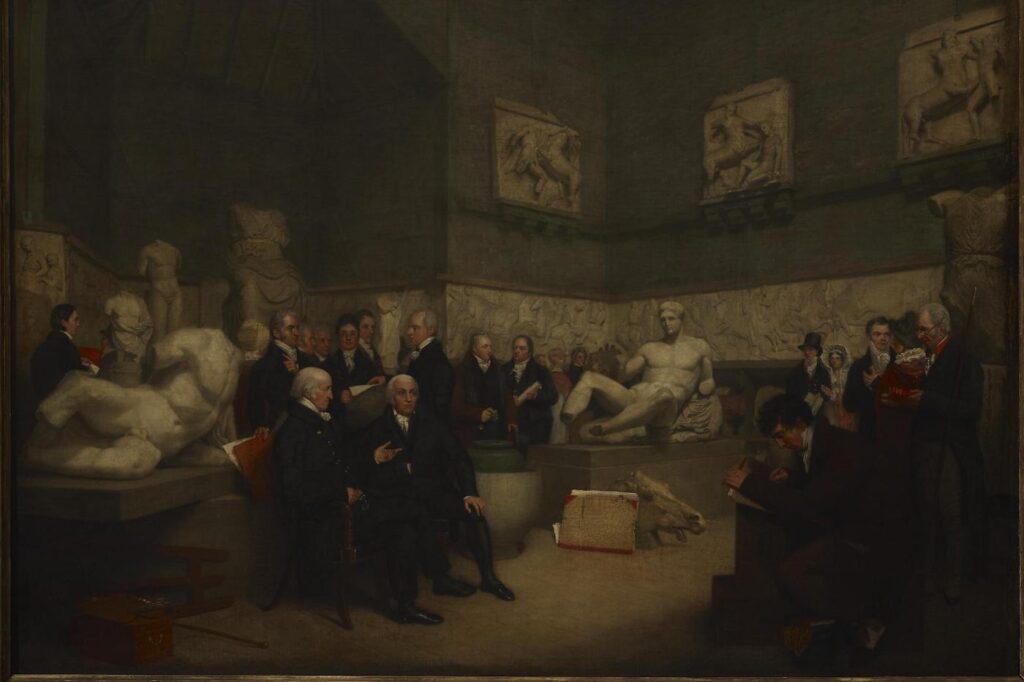Most consider museums places to spend a quiet, untroubled afternoon, not hotbeds of international controversy. But especially when it comes to ancient art, there is intense disagreement between the nations from which the art originated and the museums across the world that house such antiquities. “The world is divided on this question,” explained James Cuno in his 2008 book Who Owns Antiquity?, with “museums, private collectors and art dealers” on one side, and “archaeologists, academics, and source nation cultural ministers” on the other.” Museums generally feel that preservation and wide access to cultural heritage justify the retention of most objects. Countries of origin view these antiquities as their rightful patrimony and vehemently fight for their return home.
Among these disputes, which I like to call the “Art Wars,” one has been particularly interminable, and especially heated of late: the controversy over the British Museum’s so-called Elgin Marbles. These remarkable sculptures from the Parthenon and other Acropolis structures date from the fifth century BC and exemplify the zenith of classical art and thought. Whether they were stolen (as some insist) or rescued (as others do), the marbles arrived in London at the start of the nineteenth century due to the intervention of the British diplomat Lord Elgin (1766–1841). The Greek state asked the British to return the marbles in the 1980s, and the controversy has simmered since then. Initially, the British complained that the Greeks did not have a suitable facility to hold the marbles, and so the Greeks built one. In recent negotiations, the British have considered return of the Parthenon Marbles on a long-term loan agreement. Rumors swirl, private meetings are convened, and the public debate carries on.
If the British government were to freely give the marbles back to Greece, it would not only illustrate recent claims for the sound moral character of the British, but it would also set a good precedent for similar debates taking place among other museums and nations.
What is missing from the Parthenon Marbles debate and other skirmishes in the Art Wars is an understanding of how grace might play a role in settling these disputes. Such an absence is not surprising, for presumably “neutral” museums—founded in the Enlightenment in the wake of the European wars of religion—were designed in part to avoid any theological appeals. But grace might help anyway. If the British government were to freely give the marbles back to Greece, it would not only illustrate recent claims for the sound moral character of the British; it would also set a good precedent for similar debates taking place among other museums and nations.
Start your day with Public Discourse
Sign up and get our daily essays sent straight to your inbox.Finders Keepers
In The Telegraph, Oxford ethicist Nigel Biggar recently made an eloquent case for the British Museum to keep the Parthenon Marbles. Biggar’s account is notable not only because the author is an accomplished scholar, but because he is also a theologian and Anglican priest. Biggar might therefore be expected to bring in some robust theological vocabulary to the debate about the Parthenon Marbles, but (at least in the Telegraph article I am responding to here) he does not. Instead he disputes what he considers a poorly researched book that accuses the British of “cultural despoliations and war crimes.” Biggar’s case for retention of the marbles amounts, it seems to me, to finders keepers:
The case for retention is this. The Acropolis, on which the Parthenon stands, had been used by the Ottomans as a strategic military base for centuries. In 1687, under siege by the Venetians, a gunpowder store in the Parthenon exploded, destroying part of the building. The Ottoman authorities cared so little that the antiquarian debris was still littering the ground more than a century later when Elgin’s agents arrived on the scene. What’s more, the latter found Ottoman soldiers damaging the remaining sculptures as they prised out the lead from the clamps holding the marble blocks together, in order to make bullets. Elgin had secured from the highest official in Constantinople authorisation to take away “any pieces of stone with old inscriptions, and figures”.
Now aware of the vulnerability of the sculptures, he persuaded the city governor, in the presence of an official from the sultan’s court, that this open-ended permission extended to those, too. The work of removing the Marbles then proceeded in full public view over two-and-a-half years from 1801. The last shipment to London left nine years later. Had the authorities objected, they could easily have stopped it. But they didn’t.
Because of this, Biggar feels that the British Museum should keep the Parthenon Marbles. After all, it is only thanks to Lord Elgin that they even survived.
Barclay’s Gift
So far in the debates about the Parthenon Marbles, no one to my knowledge has brought up the idea of a gift—yet this very concept could provide the path for settling the dispute. A gift transcends guilt, shame, or restitution. A gift rules out the language of “demand,” for no genuine gift can be demanded. As theologian John Barclay lays out in his magnificent 2017 tome Paul and the Gift, ancient Greece—which carved the Parthenon Marbles—did not have a very rich understanding of the gift. “[T]o give to the stingy,” so thought the ancient Athenians, to give “to those who cannot or will not give back, would be as useless as ‘sowing seeds in the sea.’”
The Christian understanding of grace amplified the notion of the gift in ways that were hitherto only dimly imaginable. At least six such ways, in fact. Barclay spells out the Apostle Paul’s notion of grace, describing its “six perfections.” These include (1) superabundance, that is, an extravagance of scale; (2) singularity, that is, the giver gives not due to a recipient’s merit but from the giver’s own goodness alone; (3) priority, meaning the gift chronologically precedes any initiative of the recipient; (4) incongruity, which is to say, “without regard to the worth of the recipient”; then comes (5) efficacy, that is, grace achieves its aim of imparting benefit to the recipient; and finally, (6) non-circularity, that is, grace escapes any quid pro quo arrangement.
What is lacking in Biggar’s informative account, which appeals at points to Christian principles, is just this kind of grace. The British Museum did indeed rescue and preserve the so-called Elgin Marbles. They could come to the conclusion that their reward for doing so was keeping them for over two centuries, but that now it’s time to simply give them back as a gift.
Biggar’s case for keeping the marbles at the British Museum stems from a desire to defend the British Empire’s actions against detractors who have unfairly condemned it. But this concern does not preclude the British Museum’s returning the marbles to the place where they came from on the basis of grace. In fact, to do so would illustrate the good that Biggar claims the British Empire frequently exemplified. Such magnanimity would beautifully correspond to Barclay’s first two perfections of grace, (1) superabundance and (2) singularity. If they act quickly, that is, before any Greek legal claims are successfully filed, the British might even fulfill Barclay’s category of the chronological (3) priority of the giver.
The British Museum could conclude that their reward for rescuing and preserving the marbles was keeping them for over two centuries, but that now it’s time to simply give them back as a gift.
Unworthy Recipient?
Biggar seems to suggest that Greeks are less than worthy, not having a legitimate ethnic or ideological connection to the creators of the sculptures. “The Marbles have no single, authentic meaning,” he claims. “They meant contrary things to ancient Greek peoples. They mean something different to contemporary Greeks.” The marbles cannot therefore represent the “essence of Greekness.” Fair enough. A more worthy Greek recipient would not accuse the British of brazen theft; nor would a worthy Greek recipient angrily demand the marbles’ repatriation while opportunistically deploying political theatrics at press conferences in Athens to win elections. (The Greeks have done both these things.)
But again, in Barclay’s economy of grace, marked by (4) incongruity, the fact that such worthiness is not evident just does not matter. In fact, a lack of such an attitude only strengthens the case for returning the Parthenon Marbles on the basis of their being an unmerited gift.
The penultimate perfection of grace according to Barclay is (5) efficacy, imparting benefit to the recipient, and this would be a clear result of the marbles’ return. London is a well-trafficked city to be sure, but Athens is also a major world destination. The Acropolis Museum is already beautifully staged to meet the same eye-level display that the marbles currently enjoy in London. Biggar suggests that Athens should use video technology to replicate the marbles (something the Acropolis Museum already does). But why couldn’t London take up Biggar’s idea and use video technology to replicate the marbles upon their return to Greece?
Future British children might even look to the skyline of London, with St. Paul’s Cathedral gracefully crowning her varied crenelations, and conclude—thanks to the preservation and return of the Parthenon Marbles—that their country chose to live by the principles the original St. Paul espoused.
Finally, Barclay’s last perfection of grace is (6) non-circularity. What would the British Museum get for returning the marbles? It does not matter. Perhaps nothing. Pagan notions of the gift, famously illustrated by the three circulating charites, expect recompense. But in the Christian economy as elucidated by St. Paul, one does not give to get something in back. Even so, the wonder of grace is that the benefits accrue anyway. While it might be considered disappointing to have future British sons and daughters settle for the copies that Athens must settle for today, perhaps it would not be so disappointing after all. Future British children might even look to the skyline of London, with St. Paul’s Cathedral gracefully crowning her varied crenelations, and conclude—thanks to the preservation and return of the Parthenon Marbles—that their country chose to live by the principles the original St. Paul espoused.
It might here be objected that to expect God-like grace from a mere institution is unrealistic, even presumptuous. Rest assured, despite its holding of precious biblical artifacts, I am well aware that the British Museum is not divine. But while Paul’s notion of grace is first a record of God’s activity, it also invites human emulation, even for those beyond the church. Demanding as grace may be when applied to the antiquities controversy, we need not wonder about the alternative. What Cuno called the “bouillabaisse of good intentions and [unenforceable] bureaucratic ambitions” will boil well into the future. Absurdly enough, one of its creations is actually called the Intergovernmental Committee for Promoting the Return of Cultural Property to its Countries of Origin or its Restitution in Case of Illicit Appropriation. With due respect to no doubt meticulous annals of the ICPRCPCORCIA since its inception in 1978, nothing cuts through red tape like grace.
In sum, Biggar correctly dismantles shallow arguments for the return of the marbles that are premised on guilt; but he fails to imagine a magnanimity that would return these sculptures to their original home premised on grace. Grace is a gesture that the pagan culture that created the Parthenon Marbles was unable to imagine—and unfortunately, the culture of modern museums frequently seems unable to imagine grace as well.
Maybe this is why it is the church, not the museum, that seems more capable of noncompulsory charity. Late last year, Pope Francis, choosing against a loan, simply gave back the pieces of the Parthenon in the Vatican collection to the Orthodox Archbishop of Greece (who will return them to the Acropolis Museum). Perhaps the Pope had been reading St. Paul.
Image credit: Archibald Archer, the Parthenon Marbles in a temporary Elgin Room at the British Museum, 1819. Public Domain.
Help us improve Public Discourse! Please complete our Reader Survey 2023.












